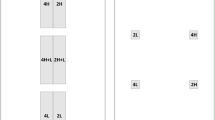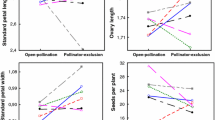Abstract
Blueberry (Vaccinium section Cyanococcus, family Ericaceae) is a shrub that produces multiple-seeded berries in which only a fraction of the ovules develop into viable seeds. A recessive yellowleaf marker gene was used to evaluate the efectiveness of a single pollination versus multiple pollinations in producing seeds in Vaccinium elliottii Chapm. A multiple-pollination experiment was conducted to see if the first pollen applied or the second produced more progeny, and to see if multiple pollinations increased the number of seedlings produced. Flowers of diploid yellowleaf Vaccinium elliottii were pollinated from one to four times at daily intervals. Pollen from redleaf and yellowleaf plants was used to produce two types of seedlings that could be distinguished visually. Generally, percent berry set, seeds per berry, and seed germination were not increased by multiple pollination. After multiple pollination, the pollen applied first always produced the most seedlings. Prior pollination greatly reduced seed set from subsequent pollination, but subsequent pollination caused little or no decrease in the number of seeds set by the first pollination.
Similar content being viewed by others
References
Bell, H.P., 1957. The development ofthe blueberry seed. Can J Bot 35: 139–153.
De Vries, D.P. & A.M. Dubois, 1983. Pollen and pollination experiments. X. The effect of repeated pollination on fruit-and seed set in crosses between the hybrid tea-rose cvs. Sonia and Ilona. Euphytica 32: 685–689.
Epperson, B.K. & M.T. Clegg, 1987. First-pollination primacy and pollen selection in morning glory, Ipomoea purpurea. Heredity 58: 5–14.
Galletta, G.J., 1975. Blueberries and cranberries. In: J.N. Moore & J. Janick (Eds.), Advances in Fruit Breeding, pp. 154–196. Purdue University Press, Lafayette, Ind.
Lyrene, P.M., 1988. An allele for anthocyanin-deficient foliage, buds and fruit in Vaccinium elliottii. J Hered 79: 80–82.
Steel, R.G.D. & J.H. Torrie, 1960. Principles and Procedures in Statistics. McGraw-Hill, New York, pp. 139–141.
Vander Kloet, S.P., 1988. The genus Vaccinium in North America. Agriculture Canada special publication 1828, Ottawa.
Visser, T. & J.J. Verhaegh, 1980. Pollen and pollination experiments. II. The influence of the first pollination on the effectiveness of the second one in apple. Euphytica 29: 385–390.
Young, M.J. & W.B. Sherman, 1978. Duration of pistil receptivity, fruit set, and seed production in rabbiteye and tetraploid blueberries. HortScience 13: 278–279.
Author information
Authors and Affiliations
Rights and permissions
About this article
Cite this article
Wenslaff, T.F., Lyrene, P.M. Results of multiple pollination in blueberry (Vaccinium elliottii Chapm.). Euphytica 117, 233–240 (2001). https://doi.org/10.1023/A:1026542017389
Issue Date:
DOI: https://doi.org/10.1023/A:1026542017389




